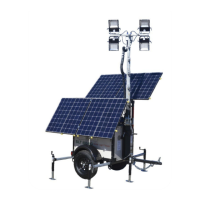3.4. Connections overview
# Name Terminal type
A Display -
B Setup button -
C Down button -
D Up button -
E Select button -
F RJ12 connector RJ2 terminal
G Buzzer -
H Programmable relay connector Push connector
I VE.Direct connector VE.Direct terminal
J Negative battery connection M10 bolt
K Positive battery connection M10 ring terminal
L Auxilary connection Push connector
M Negative load connection M10 bolt
3.5. Basic electrical connections
Connection procedure:
1.
Connect the negative battery terminal to the M10 bolt on the "BATTERY ONLY" side of the shunt. Tighten the shunt bolt with a
maximum torque of 21Nm.
Note that there should be no other connections on this side of the shunt or on the negative battery terminal. Any loads or
chargers connected here will be excluded from the battery state of charge calculation.
2. Connect the negative of the electrical system to the M10 bolt on the "LOAD AND CHARGER" side of the shunt. Tighten the
shunt bolt with a maximum torque of 21Nm. Make sure that the negative of all DC loads, inverters, battery chargers, solar
chargers and other charge sources are connected “after” the shunt.
3. Connect the ferrule pin of the red cable with the fuse to the shunt by pushing the pin into to the “+B1” terminal.
4. Connect the M10 eye terminal of the red cable with the fuse to the positive terminal of the battery.
5. Connect the shunt to the head unit using the RJ12 cable. Plug one side of the RJ12 cable into the shunt RJ12 terminal and
the other side of the cable into the RJ12 terminal on the rear of the head unit.
The battery monitor is now powered up. The display is active, and Bluetooth is active.
In order to be fully functional, the battery monitor needs to be configured; see the Configuration [12] chapter.
In case the battery monitor is going to be used to monitor a second battery, battery bank midpoint or battery temperature, see one
of the next 3 paragraphs on how to do this and then go to the Configuration [12] chapter.
Manual - BMV-712 Smart
Page 7 Installation

